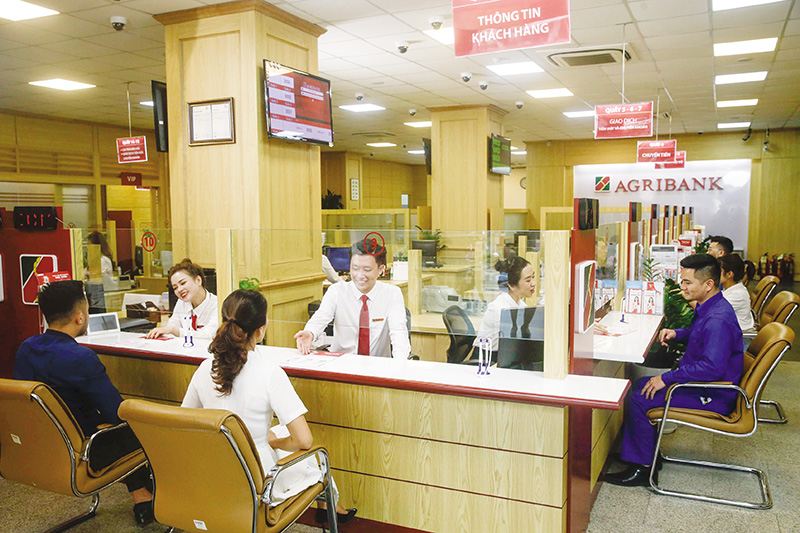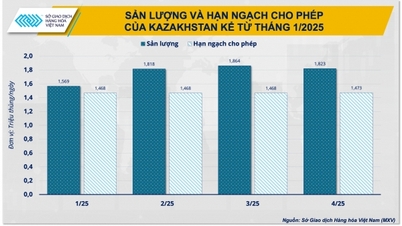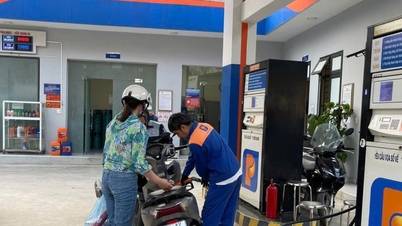 |
| Agribank is one of the banks most active in green lending in the system. Photo: Duc Thanh |
Green credit scale is still modest
Ms. Pham Thi Thanh Tung, Deputy Director of the Department of Credit for Economic Sectors (State Bank of Vietnam - SBV) said that in the past 5 years, green credit has grown by an average of 21% per year. As of March 2025, 58 credit institutions had green outstanding loans (in 2017, there were only 15 credit institutions). 57 credit institutions have conducted environmental and social risk assessments, with outstanding loans of VND3.62 trillion, an increase of more than 15 times compared to 2017. Many credit institutions have published sustainable development reports.
Although the growth rate of green credit is higher than the overall credit growth rate of the whole system, it only accounts for 4.3% of total outstanding loans, showing that the scale of green credit is still modest. In particular, Agribank is one of the banks most active in green lending in the system.
Mr. Doan Ngoc Luu, Deputy General Director of Agribank, said that the proportion of green project financing in the total outstanding credit of this bank has doubled in the past 5 years. In the first quarter of 2025, the Bank led the system in the number of customers granted credit in the green sector, with more than 41,600 customers and a total outstanding loan of nearly VND 29,300 billion. However, Agribank's green credit only accounts for 1.7% of the total outstanding loan.
At BIDV , the proportion of green credit is also very modest. Mr. Tran Phuong, Deputy General Director of the Bank, said that although they really want to promote it, banks themselves are facing difficulties when they want to lend green. Specifically, there are currently no regulations on environmental criteria and confirmation for projects granted green credit and issued green bonds; there are no specific incentive mechanisms and policies for granting green credit and issuing green bonds.
Environmental projects often have long payback periods and require large investments, which is also a challenge. In addition, the management information system and tools to support control and monitoring of green portfolios and environmental, social and governance (ESG) standards are still limited due to an incomplete legal framework...
Green credit is about to take off
Not only do banks have difficulty in granting green loans, but businesses also struggle to access green capital. Many businesses say that to easily access green capital, businesses must apply standards and practice sustainable development reporting to provide transparency in information about ESG impacts. However, the compliance process requires a huge burden of time and procedures, causing many businesses to ignore it.
- Deputy Governor of the State Bank of Vietnam Dao Minh Tu
 The implementation of the Green Credit Action Plan of the banking sector still faces many difficulties, the implementation is not uniform, many credit institutions have not generated green credit outstanding balances. The green credit results are not high although there is still much room for development. The reasons are the lack of a legal framework for green portfolios, limited risk assessment tools, long payback periods for green investment projects, and unclear financial efficiency. In addition, the mobilization of resources, especially international green financial resources, is still limited...
The implementation of the Green Credit Action Plan of the banking sector still faces many difficulties, the implementation is not uniform, many credit institutions have not generated green credit outstanding balances. The green credit results are not high although there is still much room for development. The reasons are the lack of a legal framework for green portfolios, limited risk assessment tools, long payback periods for green investment projects, and unclear financial efficiency. In addition, the mobilization of resources, especially international green financial resources, is still limited...To solve the above difficulties, not only the efforts of the banking industry are needed, but also the synchronous coordination of state management agencies, and the support of sharing experiences and resources from international organizations.

The above difficulties of enterprises will be resolved thanks to the support of AI. Dr. Le Hung Cuong, Deputy General Director of FPT Digital (FPT Corporation), said that the Monetary Authority of Singapore (MAS) is currently using AI to score ESG reports of small and medium enterprises (SMEs). This not only helps to significantly reduce loan approval time and increase access to green capital for SMEs, but banks can also comply with ESG reporting requirements more effectively.
Ms. Ngo Thuy Phuong, Deputy Head of Strategy Department (Vietcombank) said that this bank is planning to apply AI in supporting businesses to reduce the burden of meeting standards.
However, the most important thing is to overcome legal difficulties. According to BIDV representative, to promote green credit, the Government and ministries and sectors must have specific regulations on green classification, national green project certification and social risk management in credit activities. In addition, it is necessary to issue policies to encourage green growth.
Experience from many countries shows that green classification is a key factor in orienting capital flows towards green growth and helping Vietnam access global green finance.
While waiting for ministries and branches to issue specific regulations on green criteria and green classification, the positive point is that the State Bank has just launched the Handbook "Environmental and social risk management system in credit granting activities". According to Ms. Ha Thu Giang, Director of the Department of Credit for Economic Sectors, this is a product of cooperation between the State Bank and the International Finance Corporation (IFC), built according to international practices, to support credit institutions in applying ESG standards in credit activities, promoting sustainable finance goals.
Deputy Governor of the State Bank of Vietnam Dao Minh Tu emphasized that the launch of the handbook is very practical, "hand-holding" credit institutions in building specific and appropriate procedures according to the nature of each bank and loan. This is a highly practical reference document, helping credit institutions strengthen risk management according to international best practices, contributing to the effective implementation of the Banking Industry Action Plan to implement the National Strategy on Green Growth.
Source: https://baodautu.vn/go-phap-ly-day-von-xanh-cho-kinh-te-tu-nhan-d288675.html


![[Photo] Vietnamese and Hungarian leaders attend the opening of the exhibition by photographer Bozoky Dezso](https://vphoto.vietnam.vn/thumb/1200x675/vietnam/resource/IMAGE/2025/5/29/94d8ceca5db14af3bf31285551ae4bb3)

![[Photo] Prime Minister Pham Minh Chinh meets with Hungarian President Sulyok Tamas](https://vphoto.vietnam.vn/thumb/1200x675/vietnam/resource/IMAGE/2025/5/29/dbcaa73e92ea4448a03fe1d0de6d68e8)

























![[Photo] Prime Minister Pham Minh Chinh receives a bipartisan delegation of US House of Representatives](https://vphoto.vietnam.vn/thumb/1200x675/vietnam/resource/IMAGE/2025/5/28/468e61546b664d3f98dc75f6a3c2c880)






























































Comment (0)